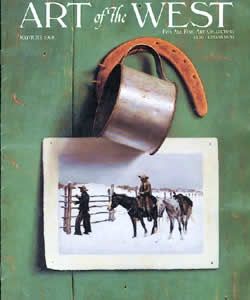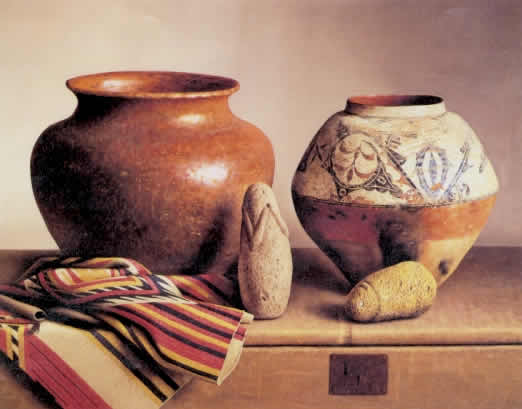TIME FOR
A CHANGE
By Nancy Gillespie
About 15 minutes
north of Taos, New Mexico, Highway 522 stretches straight as an arrow
across mesa land. On both sides of the road, the increasing development
of a once rural area are evident, a state of affairs denigrated by
natives. Privacy and a sense of serenity is a high priority for most
Taos residents.
The route to William Acheff s home and studio stands as a metaphor for his
life: a couple of twists and turns, then a remarkably straight shot to the
pinnacle of success. But, at his peak as a well known and highly regarded painter,
Acheff senses imminent change in his work. Rather than force or manipulate
those changes, however, he is willing to permit them to assume their own form
and direction.
Pointing to a still life on his easel, a small oil of tangerines so real and
so tangible they seem almost leap off the canvas, Acheff says, "I've been
doing this for 28 years." 'Me implication in his statement is simple:
It's time for change.
Such acceptance is often anathema to artists whose continuing success is wholly
dependent on a style coveted by their collectors. They can be literally trapped
in the style to which their public has become accustomed and, sometimes, criticized
by their peers.
But change is implicit in growth, and Acheff is not one to rest on his laurels
ad nauseam. "I used to paint every day, but the last year I'm painting
less," he says. "I'm looking for something different, so it seemed
natural to back off a little and reflect. I'm ready to paint other things.
I've had ideas for 20 years that will eventually come to fruition. For the
time being, I want to take a breather and think about what I want to do. Regardless
of the direction, I'll employ the same basic premise that's been behind all
of my art: light, shade, shadow, and reflection."
Whatever the nature of the change, when it manifests itself, there's no doubt
Acheff will pour his heart and soul into it. He has adapted time and again
to startlingly different environments and circumstances. Change is no stranger
to the Alaska-born artist.
'We left for San Francisco, when I was 5," Acheff says. "I had been
raised in a little town of 200 peoplethere are probably 600 now-a town in the
middle of nowhere, the place where my mother was born. I spent my first five
years with outhouses and hand pumps, so when we moved to San Francisco, I was
in culture shock."
Acheff adjusted and, for the next 20 years, lived in the Bay area. On some
undefined level, however, change was in the wind. "A friend who sold art
all over the country mentioned Santa Fe, told me about all the artists there,
and suggested a gallery that might be interested in my work," Acheff says. "I
wanted to leave California, where everything was money, money, money, and I
didn't feel I was getting any support at being an artist. I was changing, too,
becoming more inward, and there were too many distractions."
The timing was right. Three months later, Acheff and his girlfriend were in
Santa Fe, looking for a place to rent. When they didn't find anything that
met their needs, they drove to Taos. 'We arrived on the day the local paper
comes out, checked the ads, and found a place we liked," Acheff says.
The girlfriend eventually returned to San Francisco, but Acheff settled in. "I
was 26, when I came to Taos in 1973, and I'd been painting for only four years," he
says. "I was selling my work to a dealer in LA., showing in San Francisco
and Santa Rosa."
One might think, "so much, so young," but Acheff already had explored
a career as a barber that, oddly enough, provided the springboard for a career
in art. Cutting hair put him in contact with a man, who would create an enormous
change in Acheff s life-and turn a barber into an artist.
|
" I
was working in the barbershop one day, when Roberto Lupetti, an Italian
artist known in San Francisco, came in for a haircut," Acheff says. "I
was just making conversation about this and that, when Roberto
mentioned that he taught an art class. He told me I was welcome to
come to one,
if I wanted. The classes were free, he added."
Initially, Acheff wasn't interested. Although he had majored in
art in high school, he thought going to art school was synonymous
with being an art teacher,
a career that held no interest for him. "Art classes might have been the
farthest thing from my mind, but I couldn't get Roberto's offer out of my mind," Acheff
says. "Something just clicked."
Acheff attended a class the following week. "Here was this really sophisticated
teacher from Italy, so I expected to find talented students in his class," he
says. "My first day, Roberto handed me an eraser, 'if I needed it.' I
thought to myself, Wait until you see what I can do.'I started drawing and,
when Roberto came over, he said, 'Oh, I see you've drawn before."'
Acheffs first drawing was finished the following week and, hands down, was
the best in the class. He was more than equal to the competition, and he
still has the drawing. I worked five days a week, all day, for six months
with Roberto,
who let me do my own thing, let me develop," Acheff says. "He told
me in the beginning that I had what he was looking for in a student, and
I could be a professional artist. I realized he wanted to pass on his legacy
to me."
At Lupetti's suggestion, Acheff set out to complete 12 paintings in six months.
Lupetti told him that, when he was done, they would take those works to a gallery.
Acheff finished
12 still lifes and set off for a San Francisco gallery, with Lupetti's warning
ringing in his ears: "Me gallery owner is really rude, and he'll just
thumb dismissively through your work."
With that in mind, Acheff, dressed nicely and driving a sporty little Alpha
Romeo, planned to make a good impression. As luck would have it, he found
a parking place right in front of the gallery. 'The owner looked me up and
down
and said, 'Who are you?... Acheff recalls. "I explained and brought
my paintings in. Just like Roberto said, the man thumbed through them and
finally
told me, 'I'll give you $25 each; I can write you a check right away."
Acheff refused the offer; Lupetti had told him to ask for $50 each. "Well,
I'll go out of the room and let you think it over," the dealer said.
Again, Acheff said no, that he wanted $50. The dealer said he'd never get
it.
" I packed up my paintings, walked out, and approached another gallery up
the street," Acheff says. "Mey told me they weren't taking any new
artists. Discouraged, I went back to Roberto, who went with me to a gallery
in Sausalito. 'Mey bought one and took three on consignment."
It was an auspicious beginning, but to Acheff s friends, "it looked as
though I were going backward," he says. 'They felt sorry for me, and
one friend even said, unequivocally, that I was going to starve. The key
was pretty
basic; I lived within my means."
Acheff won acceptance in a Burlingame gallery, where his work immediately
began to sell. "In 1971, the art market got tight, and I started selling to
a dealer in LA," he says. "I leamed the cold side of the business
from him-how to take it." Through that dealer, Acheff also met the man
who recommended that he move to Santa Fe.
When he landed in Taos, instead, Acheff met artist Bob Daughters, who mentioned
a local gallery. Acheff approached the owner and showed her his work. The
ensuing conversation led him in yet another direction: Indian subjects. When
he put
two of those Indian pieces in a show, one sold immediately. "Me collector
actually told me, Tm going to buy this painting, because one day you're going
to be famous,"' Acheff says. Such a statement is music to any artist's
ears, but all too often it is an unfinished melody. In Acheff s case, however,
that collector was tight.
Today, Acheff is represented by top galleries in Texas, New York, Arizona,
and New Mexico. The winner of the 1989 Prix de West Award, he claims other
honors, as well. Twice Acheff has been among the finalists for the Hubbard
Award for Excellence Show in Ruidoso, New Mexico. More recently, the Autry
Museum purchased one of his paintings for $27,000.
While Acheff waits for the elements of a new style or new subject matter to
surface, he is concentrating on some minor remodeling of a house that has grown
to 8,000 square feet. That house is the subject of an amusing-and, as yet,
unfinished story. After a sell-out show in 1978, Acheff bought the house and
30 acres in Hondo. He sold it 11 years later, and the new owner added a 2,200-square-foot
guest house.
Three years ago, Acheff bought back the property. Since then, the man Acheff
had sold it to and bought it back from has offered to buy it back from Acheff.
No one yet knows how this amusing little scenario will end. "I love this
house," Acheff says, "but I'm not attached to it. Selling it again
would leave me homeless, and that's a little disturbing. But I might travel
or build another house."
Either way, Acheff won't lose any ground. (Pun intended.) ART OF THE WEST
Magazine, May/June 1998
|

